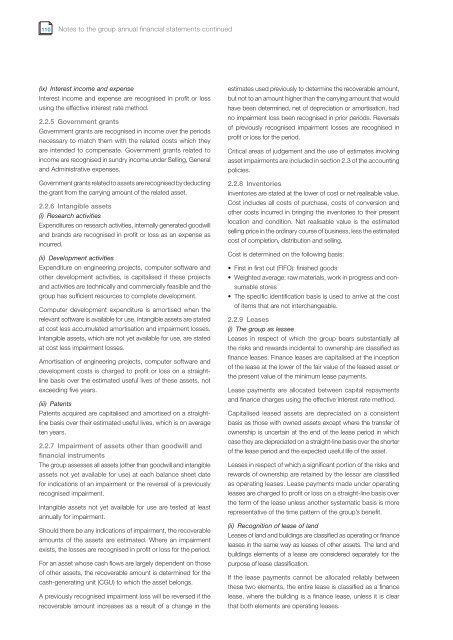Our performance in 2009 - Sappi
Our performance in 2009 - Sappi
Our performance in 2009 - Sappi
Create successful ePaper yourself
Turn your PDF publications into a flip-book with our unique Google optimized e-Paper software.
110<br />
Notes to the group annual f<strong>in</strong>ancial statements cont<strong>in</strong>ued<br />
(ix) Interest <strong>in</strong>come and expense<br />
Interest <strong>in</strong>come and expense are recognised <strong>in</strong> profit or loss<br />
us<strong>in</strong>g the effective <strong>in</strong>terest rate method.<br />
2.2.5 Government grants<br />
Government grants are recognised <strong>in</strong> <strong>in</strong>come over the periods<br />
necessary to match them with the related costs which they<br />
are <strong>in</strong>tended to compensate. Government grants related to<br />
<strong>in</strong>come are recognised <strong>in</strong> sundry <strong>in</strong>come under Sell<strong>in</strong>g, General<br />
and Adm<strong>in</strong>istrative expenses.<br />
Government grants related to assets are recognised by deduct<strong>in</strong>g<br />
the grant from the carry<strong>in</strong>g amount of the related asset.<br />
2.2.6 Intangible assets<br />
(i) Research activities<br />
Expenditures on research activities, <strong>in</strong>ternally generated goodwill<br />
and brands are recognised <strong>in</strong> profit or loss as an expense as<br />
<strong>in</strong>curred.<br />
(ii) Development activities<br />
Expenditure on eng<strong>in</strong>eer<strong>in</strong>g projects, computer software and<br />
other development activities, is capitalised if these projects<br />
and activities are technically and commercially feasible and the<br />
group has sufficient resources to complete development.<br />
Computer development expenditure is amortised when the<br />
relevant software is available for use. Intangible assets are stated<br />
at cost less accumulated amortisation and impairment losses.<br />
Intangible assets, which are not yet available for use, are stated<br />
at cost less impairment losses.<br />
Amortisation of eng<strong>in</strong>eer<strong>in</strong>g projects, computer software and<br />
development costs is charged to profit or loss on a straightl<strong>in</strong>e<br />
basis over the estimated useful lives of these assets, not<br />
exceed<strong>in</strong>g five years.<br />
(iii) Patents<br />
Patents acquired are capitalised and amortised on a straightl<strong>in</strong>e<br />
basis over their estimated useful lives, which is on average<br />
ten years.<br />
2.2.7 Impairment of assets other than goodwill and<br />
f<strong>in</strong>ancial <strong>in</strong>struments<br />
The group assesses all assets (other than goodwill and <strong>in</strong>tangible<br />
assets not yet available for use) at each balance sheet date<br />
for <strong>in</strong>dications of an impairment or the reversal of a previously<br />
recognised impairment.<br />
Intangible assets not yet available for use are tested at least<br />
annually for impairment.<br />
Should there be any <strong>in</strong>dications of impairment, the recoverable<br />
amounts of the assets are estimated. Where an impairment<br />
exists, the losses are recognised <strong>in</strong> profit or loss for the period.<br />
For an asset whose cash flows are largely dependent on those<br />
of other assets, the recoverable amount is determ<strong>in</strong>ed for the<br />
cash-generat<strong>in</strong>g unit (CGU) to which the asset belongs.<br />
A previously recognised impairment loss will be reversed if the<br />
recoverable amount <strong>in</strong>creases as a result of a change <strong>in</strong> the<br />
estimates used previously to determ<strong>in</strong>e the recoverable amount,<br />
but not to an amount higher than the carry<strong>in</strong>g amount that would<br />
have been determ<strong>in</strong>ed, net of depreciation or amortisation, had<br />
no impairment loss been recognised <strong>in</strong> prior periods. Reversals<br />
of previously recognised impairment losses are recognised <strong>in</strong><br />
profit or loss for the period.<br />
Critical areas of judgement and the use of estimates <strong>in</strong>volv<strong>in</strong>g<br />
asset impairments are <strong>in</strong>cluded <strong>in</strong> section 2.3 of the account<strong>in</strong>g<br />
policies.<br />
2.2.8 Inventories<br />
Inventories are stated at the lower of cost or net realisable value.<br />
Cost <strong>in</strong>cludes all costs of purchase, costs of conversion and<br />
other costs <strong>in</strong>curred <strong>in</strong> br<strong>in</strong>g<strong>in</strong>g the <strong>in</strong>ventories to their present<br />
location and condition. Net realisable value is the estimated<br />
sell<strong>in</strong>g price <strong>in</strong> the ord<strong>in</strong>ary course of bus<strong>in</strong>ess, less the estimated<br />
cost of completion, distribution and sell<strong>in</strong>g.<br />
Cost is determ<strong>in</strong>ed on the follow<strong>in</strong>g basis:<br />
• First <strong>in</strong> first out (FIFO): f<strong>in</strong>ished goods<br />
• Weighted average: raw materials, work <strong>in</strong> progress and con-<br />
sumable stores<br />
• The specific identification basis is used to arrive at the cost<br />
of items that are not <strong>in</strong>terchangeable.<br />
2.2.9 Leases<br />
(i) The group as lessee<br />
Leases <strong>in</strong> respect of which the group bears substantially all<br />
the risks and rewards <strong>in</strong>cidental to ownership are classified as<br />
f<strong>in</strong>ance leases. F<strong>in</strong>ance leases are capitalised at the <strong>in</strong>ception<br />
of the lease at the lower of the fair value of the leased asset or<br />
the present value of the m<strong>in</strong>imum lease payments.<br />
Lease payments are allocated between capital repayments<br />
and f<strong>in</strong>ance charges us<strong>in</strong>g the effective <strong>in</strong>terest rate method.<br />
Capitalised leased assets are depreciated on a consistent<br />
basis as those with owned assets except where the transfer of<br />
ownership is uncerta<strong>in</strong> at the end of the lease period <strong>in</strong> which<br />
case they are depreciated on a straight-l<strong>in</strong>e basis over the shorter<br />
of the lease period and the expected useful life of the asset.<br />
Leases <strong>in</strong> respect of which a significant portion of the risks and<br />
rewards of ownership are reta<strong>in</strong>ed by the lessor are classified<br />
as operat<strong>in</strong>g leases. Lease payments made under operat<strong>in</strong>g<br />
leases are charged to profit or loss on a straight-l<strong>in</strong>e basis over<br />
the term of the lease unless another systematic basis is more<br />
representative of the time pattern of the group’s benefit.<br />
(ii) Recognition of lease of land<br />
Leases of land and build<strong>in</strong>gs are classified as operat<strong>in</strong>g or f<strong>in</strong>ance<br />
leases <strong>in</strong> the same way as leases of other assets. The land and<br />
build<strong>in</strong>gs elements of a lease are considered separately for the<br />
purpose of lease classification.<br />
If the lease payments cannot be allocated reliably between<br />
these two elements, the entire lease is classified as a f<strong>in</strong>ance<br />
lease, where the build<strong>in</strong>g is a f<strong>in</strong>ance lease, unless it is clear<br />
that both elements are operat<strong>in</strong>g leases.
















